Every asset-intensive organization understands that the greater the uptime of machines, the more efficient and cost-effective operations will be. Keeping your assets in optimal working order is easier and more cost-efficient when advanced technology such as laser shaft alignment is used to increase machine reliability.
The Machine Maintenance Goal
One of the goals of every production-oriented operation is to keep its machines operating at the lowest cost yet highest productivity levels. In order to do so, proper maintenance must be performed on machines. The level of maintenance care of machines can be broken down into four major categories:
- Purely reactive or run to failure
- Basic preventive maintenance and inspections
- Combination of predictive maintenance methodologies and preventive maintenance
- Organizations making use of preventive and predictive maintenance as well as advanced technologies such as laser shaft alignment, vibration analysis, infrared thermography, etc.
At the heart of most good maintenance operations is a CMMS system that records and tracks all asset detail and maintenance work information. The premise of a CMMS is that the more asset and historical work information you have, the more efficient and effective your maintenance planning will be.
Why Shaft Alignment Technology is Necessary?
A natural extension to using a CMMS is the use of advanced shaft alignment technology because it adds valuable information regarding the condition of the machines that might otherwise go undetected until machine failure occurs.
Typical signs of misalignment include:
- Abnormally hot components, the smell of burning insulation
- Bearing issues or grinding noises
- Higher energy usage
- Load imbalances
- Rotor bar problems
- Excessive vibration
One proven method for machinery alignment is laser shaft alignment. With up to 50% of damage to rotating machinery directly related to misalignment, correcting this problem in machines is critical to production as well as operating budgets. But these are not the only reasons:
Top 7 Reasons to use Laser Shaft Alignment
Laser shaft alignment can lower your operating costs through:
- Early identification of problems enables machine maintenance to be proactive.
- Reduced maintenance cost as a result of sharp reductions in bearing, seal, shaft, and coupling failures.
- Reduced vibration lengthens the useful lifecycle of the machine as well as increases the quality of output.
- Less unplanned downtime so production can be optimized.
- Fewer emergency repairs lowering labor costs.
- Error-free and accurate measurements to 0.0001″.
- Reduced energy consumption. Poorly aligned machines require more energy to achieve the same results as a well-aligned asset.
Who Can Benefit from Laser Shaft Alignment
Laser shaft alignment can be used in any industry ranging from manufacturing to the wind power industry that depends on machinery to function. Machinery alignment is a cost-effective solution whenever critical functions are at risk. Some examples include, but are not limited to:
- Processing and centrifugal pumps used by the petrochemical industry
- Boiler feed pumps are found in every power plant and also in general industry
- Vertical turbine pumps found at water treatment plants
- Refrigeration compressors used for food processing and cold storage
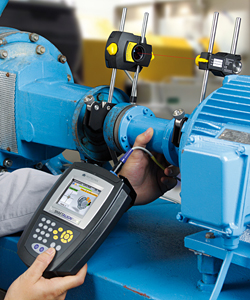 Protecting your machines through precision shaft alignment is not an option, it is a must in today’s competitive environment. Old dial indicator technology may have too low a resolution to measure accurately enough and are subject to reading errors and hysteresis or sticking dial hands. On the other hand, laser shaft alignment is error-free with reports generated directly from the instrument in conformity with ISO 9001 requirements.
Protecting your machines through precision shaft alignment is not an option, it is a must in today’s competitive environment. Old dial indicator technology may have too low a resolution to measure accurately enough and are subject to reading errors and hysteresis or sticking dial hands. On the other hand, laser shaft alignment is error-free with reports generated directly from the instrument in conformity with ISO 9001 requirements.
“7 Reasons Why Machines Need Laser Shaft Alignment” was written for us by Stuart Smith, MBA, MS. He is an avid writer about CMMS and EAM software solutions for Mintek Mobile Data Solutions. Stuart has over 25 years of experience running operations in multiple industries.
by Ana Maria Delgado, CRL
June 2011 • RELIABLE PLANT
A VIBXPERT® vibration data collector was used to collect data on a DDM 750 AC 1M drilling machine at the workshop to check for factory acceptance. The VIBXPERT allows for high-resolution time signal and spectrum measurements to be collected. The VIBXPERT can collect more than 100, 000 lines of resolution, which allows for the VIBXPERT to capture any transient events that might occur. The vibration data was collected while there was no load on the machine. The main shaft speed was 216 rpm, and the motor itself was turning at 1762 rpm.
After the vibration data was collected, the data was transferred back into the OMNITREND® software for analysis. Vibration analysis on the machine during the Factory Acceptance Test (FAT) detected impacts from the cage (train) in the pinion upper bearing.
See plots and entire case study Condition Monitoring on Drilling Platforms: A Case Study
by Mickey Harp CRL
June/July 2011 • UPTIME
Analyzing only vibration response spectra is difficult since they often don’t clearly match wall chart and textbook examples.
As anyone who has practiced vibration analysis knows, vibration signatures obtained on routes are often far from the wall chart examples. The reason for this is that the vibration signatures collected and analyzed represent the response of a system due to a variety of different forces that act simultaneously to produce one signature.
Unfortunately, vibration analysts are actually interested in determining the individual forces that cause the response. Once the forces are accurately identified, only then can they be reduced or eliminated.
Take for example the force of unbalance. Wall charts and texts on vibration analysis represent mass unbalance as a running speed peak in the spectrum that dominates all other content. Also, these theoretical, or textbook, examples indicate the vibration amplitudes will be equal in the horizontal and vertical planes. However, experienced vibration analysts know this is often not the signature we see. This is due to the fact there are multiple forces acting on the system, and it may have asymmetric stiffness resulting in highly directional vibration. In these situations, following the wall chart examples without additional phase analysis may send an analyst down the wrong path. In order to be effective in vibration analysis, it is necessary to first resolve the most dominant problem and then reanalyze the machine to determine if there are any further forces that need to be minimized. Properly identifying the most dominant problem can be difficult, so make sure to use all tools available. This case history illustrates a situation in which the vibration signature was far from being textbook due to multiple sources simultaneously acting on the system to produce one on-textbook signature. Getting to the root causes of the problem took multiple iterations.
Read the entire article Balancing Out the Root Cause by Chad Wilcox • http://www.pioneer-engineering.com/
by Ana Maria Delgado, CRL
June 2011 • PUMPS & SYSTEMS
Ensure proper bearing assessment and maintenance with this proven method
Of the methods used to assess the operating condition of rolling element bearings, one of the most successful and popular techniques is that of Shock Pulse evaluation. Shock Pulses are a special type of vibration that can be clearly distinguished from ordinary machine vibrations:
• The actual Shock Pulse is the pressure wave generated at the moment when one metallic object strikes another.
• The bulk of the impact momentum, however, acts to deform the target object, which then oscillates at its natural frequency. This vibration ultimately dissipates primarily as heat due to internal friction material damping.
Shock Pulses in Bearings
Shock Pulses occur during bearing operation when a rolling element passes over an irregularity in the surface of the bearing race. Of course, there is no such thing as a perfectly smooth surface in real life. Therefore, even new bearings emit a signal of weak Shock Pulses in rapid succession. This Carpet Value rises when the lubrication film between rolling elements and their races becomes depleted.
A defect on the surface of a rolling element or bearing race produces a strong Shock Pulse reaction with up to 1,000 times the intensity of the Carpet Value. These clusters of high amplitude peaks or Maximum Value stand out clearly from the background noise and are ideal indicators of bearing damage.
Measurement
Shock Pulses propagate within a much higher frequency range than that of ordinary machine vibration, and their energy content is relatively low.
Therefore, the accelerometer used for Shock Pulse measurement is tuned with a 36 kHz resonance frequency that lies precisely within the Shock Pulse frequency range. In addition, a 36 kHz bandpass filter is applied to the accelerometer signal to help filter out lower frequency mechanical vibration. When Shock Pulse is present the tuned accelerometer resonance is excited and amplifies the Shock Pulse signal resulting in an excellent indication of bearing lubrication and damage.
Shock Pulse is responsive even when far more energetic machine vibration is present. Therefore, lower frequency mechanical conditions such as unbalance, shaft misalignment, or vibration from adjacent machines have little effect on Shock Pulse. In addition, high-frequency signals tend to dissipate rapidly so very little interference is encountered from adjacent bearings.
Read the article Reliable Shock Pulse Evaluation of Anti-Friction Bearing Condition
Learn about our VIBXPERT II Portable Vibration Analyzer —with Full Color Display, Fast Data Acquisition and Powerful Vibration Diagnostic Tools. VIBXPERT uses the Shock Pulse method to detect lubrication condition and bearing damage.
by Ana Maria Delgado, CRL
June 2011 • TPO Magazine
ACING IT IN OKLAHOMA
Strong skills, preventive maintenance and good planning lead to success at the Coffee Creek Treatment Plant in Edmond.
The Coffee Creek Wastewater Treatment plant in Edmond, Okla., has had near-perfect compliance for 38 years and has won several awards, most recently 2010 Large Wastewater Plant of the Year from the Oklahoma Water and Pollution Control Association (OWPCA).
It all has happened with a staff of five, despite rapid population growth, several upgrades, and various episodes with collection system inflow and infiltration. “When you have only five staff, you have to focus on working smarter, not harder,” says Fred Rice, water resources superintendent for the city. This means preventive maintenance, SCADA monitoring of critical alarms, and ongoing equipment and safety training.
It’s also a matter of teamwork. Kris Neifing, chief plant operator, hired in 2004, supervises two operators, a maintenance specialist, and a lab technician, and is also responsible for one lift station at the plant and nine lift stations located throughout the collection system.
Rice credits Neifing and his staff for the plant’s track record. “Kris has really pulled everyone together as a team,” he says. “All the credit for what we’ve achieved in the last six years is due to Kris and his staff. My role is like coaching a sports team. You can coach them, but the team executes the plays.”
Says Neifing, “What makes us successful is that everybody has different skills that collectively make us the best we can be. Some are better at maintenance while others prefer operations. We believe that no one knows how to do their jobs better than the ones who do it every day.”
Continuous improvement
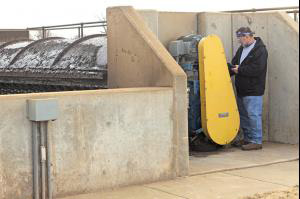
The plant’s compliance and safety record do not mean the staff is complacent. “We strive to continuously improve,” says Rice. “There is no process out there that can’t be improved, especially on the maintenance side.”
Rice and Neifing frequently attend the WEFTEC conference and other trade shows to check out the latest equipment. This has led to several innovations, such as vibration analysis and laser alignment equipment to help ensure that pumps and motors operate normally with the lowest possible maintenance. Rice and Neifing also read trade journals and network with others in the wastewater treatment business to glean ideas.
“The staff comes to us with ideas, like getting air compressors for maintenance, and suggesting better equipment or ways of doing things,” Neifing says. “We empower them to make suggestions, and we listen.” Adds Rice, “The city started a program based on the general concepts in the Good to Great book because we believe that organizations that excel are successful from the ground up. We give our employees responsibility and then hold them accountable.”
Read the entire article Acing it in Oklahoma
by Ana Maria Delgado, CRL
Recently, a flatness measurement was needed on two halves of an HP turbine shell using the LEVALIGN® system. The top half (resting upside down) was a typical quick and easy measurement, as shown below in Figure 1:
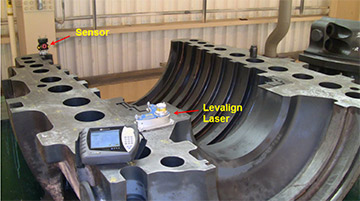
The second half was not so typical. The studs had to remain in the shell and the customer wondered if our tool could still take the measurement with the line-of-sight obstructions for the laser from the studs. The answer was YES!
The unique “InfiniSplice” feature of the LEVALIGN allowed for this to happen without having to resort to custom brackets to shoot over the top of the studs. InfiniSplice allows for multiple sets of measurements to be combined into one unified measurement. This is based on the concept that two sets of measurements can be unified or merged if they have three or more points measured in common.
It’s simple. Just measure as many points as you can with the LEVALIGN laser emitter in the first position. See Figure 2.
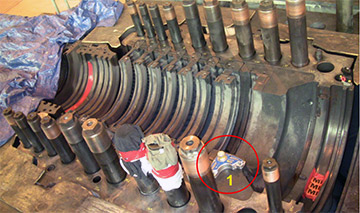
Then move the laser to another position and measure any points you couldn’t measure with the first measurement setup plus at least three points that you did measure with the previous setup. See Figure 3.
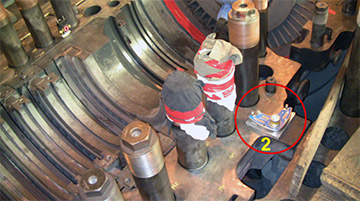
Now move the laser yet again, and repeat measuring the remainder of the points plus three points from either the first or second measurement. See the third setup in Figure 4. This process can be repeated as many times as needed, hence the term “InfiniSplice”.
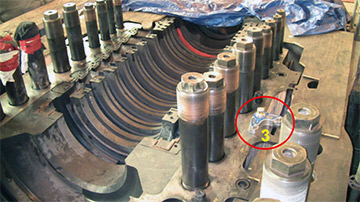
Just open all three (or more) files in the ALIGNMENT CENTER software and they are then instantly combined into one unified measurement. No need to select the splice points, the software knows which ones to use. If you can open three files, you can instantly splice them. It’s just that simple.
Figure 5 shows the combined flatness profile of the lower half of the turbine casing, taken in spite of the obstructions presented by all the studs.
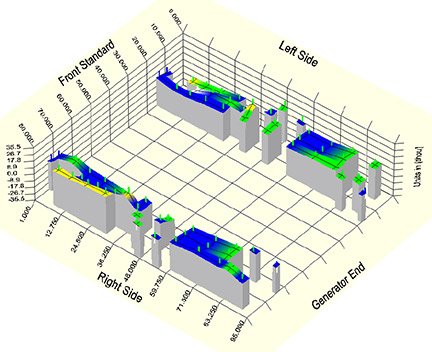
by Daus Studenberg CRL
May 2011 • MAINTENANCE TECHNOLOGY
Cardan Shaft Alignment: These applications aren’t as straightforward as others. Their special considerations call for special tools and approaches.
A Cardan shaft is, in the simplest terms, a spacer shaft with a universal joint coupling on each end. (Its name comes from a 16th-century Italian mathematician, Girolamo Cardano.) This type of arrangement allows power to be transferred between two machines that are offset from each other.
Widely used in industry, Cardan shafts have proven practical in applications where space is limited—as well as in situations where an element in the machine train (e.g. paper roll) may need to be actuated (dynamically positioned) to an alternate position when the machines are not running. The universal joint allows for limited movement without uncoupling. To ensure sufficient lubrication circulation, which in turn prevents the universal joints from seizing, Cardan shafts are normally installed with an angle from 4 to 6 degrees at the universal joints. Experience, though, has shown that the angle between the shafts of the driver and driven unit should be kept to a minimum, preferably less than 4.36 mrads (0.25 degrees). Ideally, the angles between the driver and driven shafts and the Cardan shaft, shown as ?1 and ?2 in Fig. 1, would be equal. Geometrically, this would equate to zero angularity existing between the driver and driven unit: In other words, the shafts of the driver and the driven machine would be parallel to each other.
Read the entire article Cardan Shaft Alignment featuring the ROTALIGN ULTRA laser alignment tool suited for cardan-shaft applications.
by Ana Maria Delgado, CRL
March 2011 • IMPO MAGAZINE, iPurchase Supplement
As the American economy recovers, how aware, or active, are manufacturers concerning predictive maintenance?
Most manufacturers never lost the desire to increase their overall reliability and predictive maintenance efforts during the recent economic slowdown. Some companies did postpone purchases of predictive maintenance-related products. However, a lot of companies realize that an investment in predictive maintenance technologies is a viable means to decrease overall maintenance expenses, so they do it the right way. A lot of manufacturers, as a result of this understanding, continued to invest in predictive maintenance-related technologies during the recent economic slowdown. This allowed them to reduce overall maintenance costs and place their company in a more competitive position once the economy recovers. Interest in these products is higher this year as companies continue to invest in vibration- and alignment-related products to reduce their costs. increase competitive advantages, and manufacture equipment reliability.
Read the entire interview Q&A Roundtable from iPurchase, a supplement from IMPO Magazine including:
Are there any interesting trends occurring in the maintenance market?
Why do you think laser alignment is important to a manufacturer’s maintenance strategy?
How would you recommend a manufacturer approach the creation of a more robust maintenance plan?
by Trent Phillips
February 2011 • WORLD CEMENT
Robert Schmaus, Prüftechnik Condition Monitoring GmbH, Germany, outlines the benefits of applying online condition monitoring systems.
What is condition monitoring?
Condition monitoring is the process of monitoring machinery health or machinery condition, such that a significant change is indicative of a developing failure. It allows maintenance to be scheduled, or other actions to be taken to avoid the consequences of failure before the failure occurs. The main goal of condition monitoring, therefore, is to improve plant production capacity and make the process more profitable. Different maintenance strategies have been adopted by maintenance personnel – starting from pure ‘breakdown maintenance’ (run the machine until breakdown without intervention), preventive or time-based maintenance(scheduled maintenance stops), to predictive maintenance. Having adopted a predictive maintenance strategy- in a plant, maintenance stops for interventions required are scheduled according to machine conditions and not by mere periodical interventions, as is the case in time-based maintenance. Predictive maintenance enables operators to take advantage of the lifetime of machine components and minimizes required spare parts stock, as repairs are effectuated according to the condition of machines and not on a periodical basis. As developing failures can be detected in time, consequential damages are avoided. Improved machine reliability minimizes interruptions to the production process.
Download the entire article Online CMS – Value for Money?
by Ana Maria Delgado, CRL
March 2011 • WindPower Engineering
Condition-monitoring systems have made it clear that wind turbines are complex machines in which overall vibration values must be systematically determined and evaluation references made available. Points to consider when writing evaluation guidelines for wind-power plants include:
• Function and structural design of wind turbines and their components
• Interaction between the individual drivetrain components (modules) being tested
• Information and experience regarding the possible faults and damages occurring in the individual testing modules during operation and their economic impact
• Knowledge of operation-related and machine-related vibration influences, the diagnostic procedures that must be adhered to, and their respective limits
The recent VDI 3834, established and released in 2009, takes into consideration the special requirements for evaluating wind turbine components. The guideline is set for turbines ranging from 100 kW to 3 MW.
Read our article Finally, ISO Guidelines for Condition Monitoring
by Alex Nino CRL
Water/Waste Processing Magazine • February 2011
A southeastern US water company has been developing a condition monitoring program with LUDECA as their partner, to monitor their on-surface equipment with VIBSCANNER® and VIBCODE® systems. The current program has provided significant benefits and cost savings by preventing expensive pump and motor failures, as well as optimizing their current maintenance planning and procedures. However, sometimes not all equipment can be monitored using a portable device, either for safety reasons or location. A recent problem arose at the wastewater treatment plant. The facility experiences high flows and because of the small relative space available, they use chemical and aeration treatment processes to meet code and final water approval levels. The flow works by deep tunnels that run beneath the city terminating at a deep pump well 121 feet in depth (37 meters). It is pumped by four submersible pumps to the plant’s inlet. These pumps have caused extreme revenue and capital cost in both repairs and operations.
Download the entire article “Online Condition Monitoring – Monitoring Waste the Easy Way”
by Alex Nino CRL
WaterWorld Magazine • February 2011
A Florida water treatment plant recently discovered that having full-flex (double engagement) gear couplings at either end of a spacer shaft connecting a Lufkin gearbox to a 13, 000 GPM Worthington water pump caused self-exacerbating vibration that eventually destroyed the gearbox twice within 3 months, requiring a full rebuild each time. After the second rebuild and re-installation, LUDECA was called in to monitor positional changes between the stopped and running conditions of the entire diesel engine-driven machine train with its PERMALIGN® system to derive true target specifications for the “cold” condition. Thereafter, a laser re-alignment to exact tolerances would be performed to the new targets…
Read the entire case study and view photos
by Alan Luedeking CRL CMRP
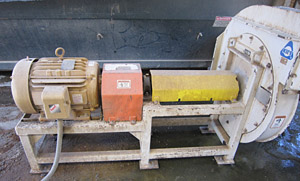
Problem: Exhaust fans
The exhaust fans at two of our process buildings kept having the same common faults (failed bearings, failed motors, and running hot.). We spent over $4, 400.00 on one fan from 2008 to 2010 and over $5, 600.00 on the other fan on parts alone.
Solution: Purchased an OPTALIGN® SMART EX laser alignment system
In July 2010, we received our new OPTALIGN SMART EX and had LUDECA come in and give us an introduction introductory training course. After a few trials on using the laser alignment tool on a motor and pump that we set up in the shop, we were ready to take it out in the field. We went and set the tool up on our two exhaust fans and found out there were way out of alignment. After a few tries, we had smiley faces on both machines in the horizontal and vertical directions. Since the alignment, we haven’t had any more problems with either fan. The OPTALIGN SMART EX is very user-friendly and well worth the money.
Now we have incorporated the OPTALIGN SMART into to our PM program to check the alignment on all rotating equipment as they come up for a PM. In the last few months we have been using it, we are getting good feedback from the maintenance department on how easy it is to use and how much time is saved, instead of doing it the old way (dial indicators). —Bryan Brown, PM Technician with MARTEK Biosciences in Kingstree, SC.
by Ana Maria Delgado, CRL
In December 2009, an aerospace industry service company in Florida was presented with an unusual challenge. A furnace that had exploded was believed to have suffered severe deformities at the mating flange surface. They were now faced with the task of determining whether or not the furnace flange was flat. LUDECA was contacted for assistance in determining whether or not the flange surface was still within allowable tolerances prior to the unit being rebuilt. Upon arriving at the job site, it became apparent that this was no ordinary flange flatness measurement job. After the explosion, the entire unit had been sent for overhaul and inspection, and both the bottom and top portions were split apart. The job entailed determining flatness for the top half of the flange, which was still connected to the structure and was located in an inverted orientation. Using the INCLINEO® High Precision Inclinometer system, LUDECA had thus far performed many field service jobs for flatness, straightness, and angularity, but all of these had been right-side-up or non-inverted applications. LUDECA’s field engineering began by inspecting the surface conditions, taking length and diameter measurements, and laying out a grid pattern. This was to be the first inverted job ever done with the INCLINEO, whose ability to measure angles, flatness, straightness, levelness, plumbness, and surface inclination would prove to be ideal for this application.
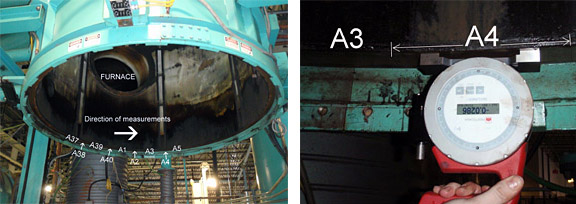
The flange was sectioned off into 40 segments, and labeled every 7.5″. With INCLINEO’s simple 3-button interface, wireless PC communication capabilities, and ALIGNMENT CENTER software on a laptop, readings were taken at each segmented point, and both 2-D and 3-D contour plots of the flange surface were generated. With the advancements in geometric measurement technologies, the Inclineo’s high accuracy resolution of 0.0003°/inch determined that the flange was, in fact, out of tolerance from the expected maximum peak-to-peak value of 0.040″ to a measured value of 0.131″.
by David Atehortua
Pumps & Systems • January 2011
Aligning an electric motor coupled to a large air blower required multiple measurements.
Around 18 years ago, a client needed assistance aligning an electric motor (more than 1, 000 horsepower) coupled to a large air blower. This was a critical piece of equipment that was routinely shut down for preventive maintenance at regular intervals to ensure trouble-free operation. The mechanical contractor used for this alignment was reputable, and the customer had used him several times in the past for this task with satisfactory results.
Vibration Problems
Upon startup, vibration levels were so high that the package tripped and shut down before reaching full rpm, preventing any meaningful collection of vibration data to help identify the problem. This continued for two days. Convinced that the problem was alignment-related, the contractor made multiple corrections with the same results. Every time the package was started, vibration levels were high, and the package shut down before reaching full rpm.
Laser Shaft Alignment Assessment
The client requested that a shaft laser alignment system be used to ensure correct alignment. The motor and the blower were uncoupled, and all the hold-down bolts were at spec. Initial readings were taken. Remember, this was more than 18 years ago, so the alignment system was a much less sophisticated system than those available today.
Read the entire article Measure Twice, Cut Once!
by Dennis Onken
www.facilitiesnet.com • November 2010
Many manufacturing facilities use vibration analysis to detect early signs of machine failure, allowing technicians to repair or replace machinery before a catastrophic failure occurs. All rotating equipment vibrates, but as components begin to fail or reach the end of their serviceable life, they begin to vibrate more and in unique ways. Ongoing monitoring of equipment allows technicians to identify these indicators of wear and future damage well before the damage becomes a total failure. When technicians use condition monitoring correctly, it can result in significant cost savings compared to traditional maintenance approaches. In traditional maintenance approaches using preventive maintenance, technicians would replace these faulty components on a fixed schedule. In a reactive-maintenance scenario, technicians would repair or replace these components only after they have reached total failure.
Read the entire article Vibration Analysis Avoids Equipment Failure by Dave Bertolini, People and Processes, Inc.
by Ana Maria Delgado, CRL
Machinery Lubrication, September • October 2010
In his book “Machinery Vibration: Alignment”, noted author and expert on precision alignment Victor Wowk illustrates the relationship between misalignment and loss of machine life. Of course, some equipment is more or less tolerant to misalignment depending on bearing type and coupling type. Likewise, the effects of misalignment are magnified as a function of speed.
Read the entire article Shaft Alignment has a Bearing on Lubrication Excellence
by Ana Maria Delgado, CRL
Reliable Plant • October 2010
Vibration analysis is mostly a learned skill. It is based 70 percent on experience and 30 percent on classroom training and self-study. It takes years to become a confident and competent vibration analyst. When the analysis is wrong, the recommendations for repair also will be incorrect. No vibration analyst wants to make the wrong call. In this business, credibility is gained in small steps and lost in large chunks. A vibration sensor placed on a bearing housing and connected to a vibration analyzer provides time, frequency, and amplitude information in the form of a waveform and a spectrum. This data is the foundation for vibration analysis. It contains the signatures of nearly all mechanical and electrical defects present on the machine. The vibration analysis process involves determining the vibration severity, identifying frequencies and patterns, associating the peaks and patterns with mechanical or electrical components, forming conclusions, and, if necessary, making recommendations for repair. Everybody involved in vibration analysis knows that analyzing vibration is not easy or automated. Have you ever wondered why?
by Tony DeMatteo
Take a look at what it takes to become a certified maintenance and reliability professional.
One time-honored way to lay claim to proficiency in a body of knowledge and the respect that comes with it is certification. From doctors and lawyers to real estate agents and pest-control specialists, earning or buying impressed pieces of faux parchment suitable for framing, the right to add a string of initials after one’s name and the pleasure of regular renewal obligations have been beneficial to career success, if not an outright requirement, of doing business in a given profession.
Read the entire article: Are you certifiable? | Plant Services.
by Ana Maria Delgado, CRL
POWER-GEN Worldwide, September 2010
The alignment of turbine-generator sets poses unique challenges that only the best laser shaft alignment systems can overcome. Not the least of these is the difficulty of turning the shafts (either coupled or uncoupled) and the methods employed in turning them. The intent of this article is to present a few of these challenges and the solutions to them.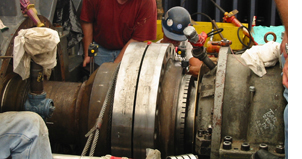
Shaft Rotation
Since a turbine-generator train cannot be readily rotated by hand (unlike most other smaller machine sets), external “helper” forces must be enlisted, such as an overhead crane with a sling around the shaft or coupling. As the crane applies rotational force it also lifts the shafts in the bearings a little, changing their relative alignment and true position in the bearings. This makes using the Continuous Sweep measure mode impractical since you do not want to corrupt the validity of the alignment data you are collecting as you rotate the shafts. The same concerns also apply to other methods, such as the chain fall and pin method…
Read the entire article Turbine-Generator Alignment featuring the ROTALIGN ULTRA alignment system.
by Ana Maria Delgado, CRL
